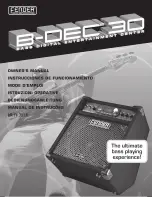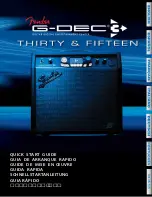
AT500NC Manual
Rev-10/17
Suggestion #2:
Turn off all components in your system, and then dis-
connect the input cables at the amplifier. Turn the am-
plifier back on, and see if the hum is still present. If the
hum disappears, the fault may be in the input cables
used. Try replacing them with cables that have better
shielding, and make certain that the input cables are not
running on top of any AC power cords. Change the ca-
bles one at a time to determine if one, or all cables is
responsive. If the hum disappears when the input cables
are disconnected, but returns after the cables are
changed and the system re-connected, the problem may
be caused by your source device.
Suggestion #3:
Ground loop problems may also be caused by poor
grounding of the electrical system in your home, partic-
ularly when there are multiple components with three
prong, grounded, power cords. Try unplugging these
components one at a time, and see if one or all of them
is causing the problem. The ultimate solution to this
type of problem is to re-wire your house with an isolat-
ed, star type-grounding configuration. We recognize,
however, that this may be impractical and expensive. In
some cases, the use of an approved AC Power Isolation
Transformer of sufficient capacity may solve this prob-
lem.
WARNING:
If you suspect that the grounding system
in your home’s electrical wiring is causing the hum
problem, it is important that you do not make any
changes to the wiring yourself. Only a licensed electri-
cian should make any changes to household wiring,
and they must be made in full compliance with all local
building, safety and electrical codes.
Suggestion #4:
Hum may also be caused by faulty earth grounds in
your home’s electrical system. In the past, cold water
pipes were often used for the earth ground, so it is im-
portant to make sure that your ground connection is
still valid and has not become loose or corroded. The
cold water pipe method may no longer be valid in some
locations due to requirements that the water meter be
isolated from the water mains with a length of PVC
pipe, thus interrupting the ground circuit. The safest,
and most reliable, approach may be to provide your
own ground. This can be accomplished by having a
licensed electrician drive at least five feet of copper-
jacketed steel grounding rod into the earth, and using
that for your grounding connection. If the hum persists
after all of the above suggestions have been tried, con-
tact the ATI customer service department for assis-
tance.
9
































